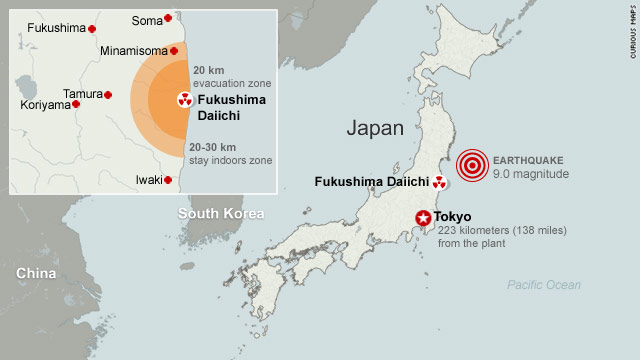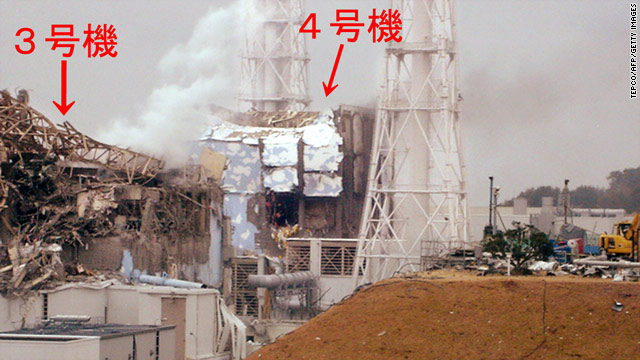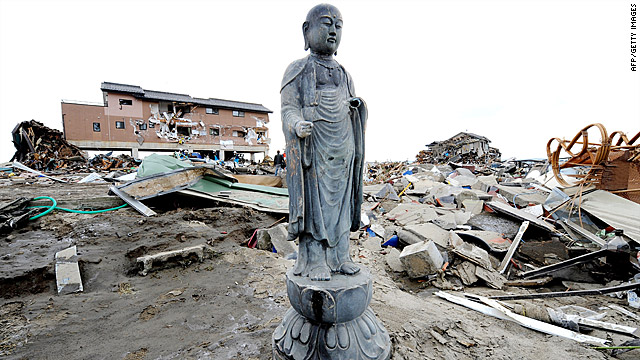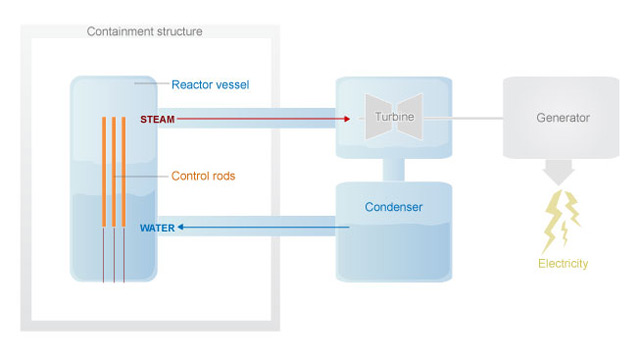Tokyo (CNN) -- Efforts to cool one of the reactors at a quake-damaged Japanese nuclear power plant have been "somewhat effective" since authorities turned helicopters, fire trucks and police water cannon on the facility, its owner said early Friday.
Japanese military helicopters dumped tons of water on the No. 3 reactor housing, including its spent fuel pool, at the Fukushima Daiichi plant until after midnight Thursday, the Tokyo Electric Power Company reported. Earlier, fire and police trucks turned their hoses on the No. 3 reactor housing for more than an hour, TEPCO reported, and the subsequent steam and lowered radioactivity levels indicated progress.
Experts believe that boiling steam rising from that pool, which contains at least partially exposed fuel rods, may be releasing radiation into the atmosphere.
In Vienna, Austria, a senior official of the International Atomic Energy Agency told reporters the situation remains serious, but there had been "no significant worsening" Thursday.
 Nuclear plant tries restoring power
Nuclear plant tries restoring power  Japan's power plant from the air
Japan's power plant from the air  Spokesman outlines Japan plant radiation
Spokesman outlines Japan plant radiation  Map: Fukushima Daiichi
Map: Fukushima Daiichi The damage to the nuclear reactors at Fukushima Daiichi has raised the specter of a multiple nuclear meltdown -- the nightmare scenario more common in movies than in reality in which fuel rods cannot be cooled and the reactor's core melts. In the worst-case scenario, the fuel can spill out of the damaged containment unit and spread radioactivity and cancer-causing isotopes through the air and water.
Radiation levels at the plant dipped Thursday evening, but remained high after spiking Thursday morning to nearly 3.8 millisieverts per hour -- more than a typical resident of a developed country receives in a year. But Japan's Nuclear and Industrial Safety Agency said 17 of 18 workers checked Thursday morning tested normal, and the one who received a higher dose of radiation required no medical treatment.
"The radiation levels of individual workers are being properly managed by limiting their time in or close to the reactors," Hidehiko Nishiyama, NISA's deputy director-general, told reporters.
Meanwhile, engineers got an emergency diesel generator for Unit 6 running that was supplying energy to Units 5 and 6 for use in cooling the spent-fuel pools, a spokesman for the Nuclear and Industrial Safety Agency said Friday. Water injection to the spent fuel pool was continuing.
Also, officials gave confusing reports about the status of a new cable intended to restore power to unit No. 2. The International Atomic Energy Agency, citing "Japanese authorities," said the power cord had reached the unit and that it would be connected once spraying of water on the No. 3 reactor building had been completed.
But a TEPCO spokesman in the Tokyo bureau told CNN that the electrical line had not been connected, though officials hoped to get it connected by the end of Friday.
In four helicopter water drops Thursday morning, little water appeared to hit the No. 3 reactor building. Video aired on NHK showed that only one of the loads appeared to drop directly on the building.
Friday's earthquake and tsunami caused damage at four of the six reactors at the Fukushima Daiichi plant, located on the northern coast of the Japanese island of Honshu. Restoring power would help get the plant's pumping systems going again, to try to get water to the reactors and their adjacent pools for housing spent fuel.
 When will the Japan crisis end?
When will the Japan crisis end?  How bad is Japanese radiation risk?
How bad is Japanese radiation risk?  Gallery: Japan reeling after massive quake
Gallery: Japan reeling after massive quake  Explainer: Producing nuclear energy
Explainer: Producing nuclear energy RELATED TOPICS
Thursday's efforts were focused on the No. 3 reactor, the sole damaged unit that contains plutonium along with the uranium in its fuel rods. But high concerns remained about the spent fuel pool at reactor No. 4, where the IAEA said no water-temperature data has been received since Monday and a U.S. official said Wednesday appeared to contain no water.
"The current situation at units 1, 2 and 3, whose cores have suffered damage, appears to be relatively stable," said Graham Andrew, a top aide to IAEA Director-General Yukiya Amano. "Unit 4, in particular, remains a major safety concern."
Gregory Jaczko, the head of the U.S. Nuclear Regulatory Commission, told a congressional committee Wednesday that there was "no water" in the No. 4 pool, resulting in the emission of "extremely high" levels of radiation. But Japanese authorities disputed Jaczko's assertion, citing information gathered from a helicopter flight over the plant. A TEPCO official said Thursday that there was some water in the No. 4 spent fuel pool, "But we do not know how much water."
The Union of Concerned Scientists has warned that a mixed-oxide fuel like the kind used in reactor No. 3 could cause more harm than regular uranium fuels, since it has a lower melting point and can produce other radioactive elements. But Andrew said the IAEA did not consider the presence of mixed-oxide fuel in reactor No. 3 an especially significant concern, since plutonium is also a byproduct of the fuel used in other reactors.
Rebecca Johnson, founder of the London-based Acronym Institute for Disarmament Diplomacy, which promotes international security, disarmament and arms control, told CNN that Japanese engineers were "flying by the seat of their pants now ... Everything they try goes wrong. They're focusing on reactors, then spent fuel becomes damaged," Johnson said. "They've just got to get water in there, keep the water pumping."
And nuclear engineer Arnie Gundersen told CNN that the effort will likely need to be sustained "for months, if not years."
"What's pushing the firemen back is the radiation that's coming from the spent fuel pool," he said. If the spent fuel rods in that pool are uncovered, "There's an awful lot of gamma rays flooding that site, forcing the workers to say further away."
The U.S. Nuclear Energy Institute, a trade association for the American nuclear power business, said aerial photographs of the site backed up the Japanese assessment. The steel liner of the coolant pool remained intact, but the surrounding wall had collapsed on one side, it reported.
Nishiyama acknowledged that some data from the Daiichi plant may not be reliable as the quake knocked down power on site, rendering measurement equipment unstable. He was quick to defend how the government has handled information on the nuclear plant.
Public health officials say the release of radiation from a meltdown can cause immediate and long-term health problems, including radiation poisoning and cancer. About 200,000 people living within a 20-kilometer (12-mile) radius of the plant have been evacuated; those living 20 to 30 kilometers from the site have been told to remain inside, and Japan has banned flights over the area.
Tests in the city of Fukushima, 80 kilometers (50 miles) from the plant, found radiation measuring above the average reading but still well below the level considered harmful to humans. Small, harmless amounts of iodine -- a potential byproduct of a nuclear meltdown -- were found in the city's water.
Citing Fukushima Prefecture officials, Kyodo News reported Thursday that about 10,000 people had been screened for radiation exposure the previous day at evacuation centers and medical offices.
Koichi Shiga described the town of Minamisoma, 25 kilometers from the plant and site of the Hotel Iseya, which he owns, as ghostly quiet with most all shops closed and empty streets. Electricity and water were still flowing, though evacuation efforts had been hampered by a paucity of gasoline.
"People have not evacuated, they are staying at home," Shiga told CNN. "There was a ration of 10 liters of gas, and I saw a long line of people."
Several countries, including the United States, have called for a broader safety range, urging their citizens in Japan to evacuate or at least stay indoors if they live within 80 kilometers of the Fukushima Daiichi plant.
One positive development is that winds have been blowing from the northwest, helping push emitted radiation off to sea. Still, at least 20 people have fallen ill due to possible radiation contamination, in addition to 19 injured and two missing at the plant, according to the IAEA.
No comments:
Post a Comment